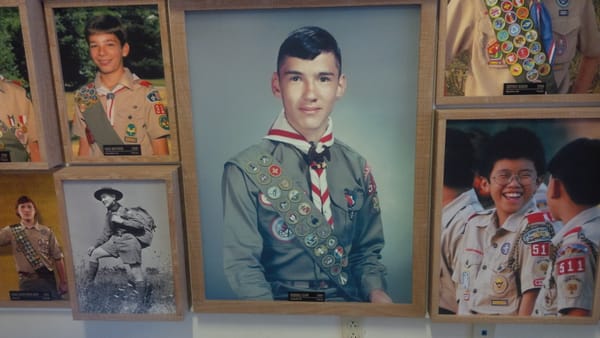How to find an LGBTQ+ inclusive troop
A step-by-step guide to finding the right Scouting unit for you and your family—no matter where you live.

On paper, young people of all sexual orientations and gender identities are welcome in the Boy Scouts of America.
This seems obvious, but it’s worth reiterating that current policy mandates all Cub Scout packs and Scouts BSA troops accept LGBTQ+ youth.
But policy is one thing, and culture is entirely another. Anyone who has navigated Scouting in recent years knows that LGBTQ+ kids are not always warmly embraced by all troops or packs. So how do you find a unit that truly affirms you or your child?
I spoke to a number of experienced Scouters to find out. In this step-by-step guide, I’ll give you advice on scoping out potential units, vetting leadership and deciding which one is right for you.
Step 1: Make a list of local units
Before you can find an inclusive BSA unit, you need to know what your options are. Depending where you live, there are likely a whole bunch of Cub Scout packs or Scouts BSA troops operating in your town or city.
You can head over to BeAScout.org, punch in your ZIP code, and see a complete list (or map) of the packs and troops in your area. You can also ask around to see if any friends or neighbors know about local Scouting units.
Jot down the ones that are nearby or otherwise interesting to you. No need to be too selective at this point—you’ll narrow down your options in the next step. For now, just make a list of the units that are available.
Step 2: Do some online detective work
Okay, so you’ve got your list of units. But not all units are created equal.
“We need to be our own detectives and do a little sleuthing,” says Stacey Capell, a scoutmaster in the Washington, D.C. area who has personal experience seeking out an inclusive troop for her own kids.
The first thing you’ll want to find out is what organization is chartering each unit. A chartered organization is the entity that sponsors each local scout troop or pack. It’s usually a church, fire department or some other type of civic group.
Chartered orgs lend the meeting space (think: a church basement) and are also involved in selecting the adult volunteers for the unit (we’ll talk more later about why that’s important).
Understanding the chartered organization can give you some clues about inclusivity. A conservative religious denomination, for example, might be less likely to run an inclusive troop than, say, a parent-teacher association.
And remember that BeAScout.org website I mentioned earlier? That can also give you some clues. Look at the blurb for each unit. At the very least, it probably gives the meeting day and time. But some units also include phrases like, “all are welcome” or “inclusive troop.”
If the unit has a website, you also want to check that out. Many inclusive troops go out of their way to make it known, including Pride flags or other imagery on their site. But sometimes it’s even more subtle, Capell says: The use of the terms “parent/guardian” instead of “mother/father,” or calling youth members “scouts” instead of “boys and girls.”
Step 3: Select a few units to visit
Take a breather. You’ve just done a lot of research. “A lot of it really becomes work and tedium for the family that’s looking,” Capell says.
But hopefully that exercise helped you cross a few units off your list, and narrow it down to a handful of good candidates.
Now it’s time to see some of them in person: Arrange to visit pack or troop meetings for the units that are at the top of your list. Ideally, both the parent and prospective scout should visit together. Tell the units you’re visiting a few and just getting a sense of each one before you commit to anything.
When you’re there, try to talk to as many people as possible. Don’t just rely on the one person giving you a tour: See if you can talk to multiple families in the unit, or at the very least chat up parents in the parking lot, Capell suggests. You’re trying to get a sense of the culture of the unit.
Ultimately, this step is all about putting your internet sleuthing to the test. Does the online presence for the unit match up with reality? Is it better or worse? And how did it feel being there?
Step 4: Have a conversation with troop leadership
While you’re making these troop or pack visits, you can also try to vet the adult leadership.
“Be willing to have some of those hard conversations with the leadership team,” says Jamie Goodrich, a Scouting volunteer in the Boston area, who has her own kids in the program.
This is the time to ask any specific questions you have, such as how the unit handles tenting on campouts. You can also ask to see any written bylaws or codes of conduct the troop has.
“You should always ask what role your charter org is playing in your day-to-day operations of a unit, and then figure out whether you’re comfortable with that,” says Capell. Some chartered organizations play little-to-no role in troop operations, while others are more hands-on. All units are required to accept LGBTQ+ youth, but chartered orgs can still reject LGBTQ+ adult volunteers based on religious convictions. “It’s worth finding out how influential they are,” Capell says.
But ultimately, the specifics may matter less than the overall vibe you get from this conversation. “You're going to be able to tell within a few minutes of talking to them whether they’re genuine or not,” Goodrich says.
Step 5: Go with your gut (and trust your kid)
Once you’ve done your unit visits, you’ve got a lot of information about potential packs or troops to join, and hopefully you’ve narrowed down your list even more.
But it’s entirely possible you’ll have more than one great option to choose from. Now what?
Capell has simple advice: “Let the kids decide.” What parents like best isn’t always what the scout likes best, especially if they were split up during the unit visit. And even in units where leadership says all the right things and has the best of intentions, it might not translate to the youth experience. “Trust what your scout is telling you based on the experience they just had,” Capell says.
Goodrich’s advice is equally straightforward: “Go with your gut feeling on it.”
But one other thing to consider, is how much education you’re willing to do, as a scout or a parent. Sometimes you’ll find a unit whose heart is in the right place, but still needs a lot of help becoming an affirming place for LGBTQ+ scouts. ”You have to decide where you’re willing to step in,” Capell says. In more rural areas with fewer troops, you might not have a choice, and the kind-hearted unit that requires a bit of education might be your best bet.
Step 6: Check-in and re-evaluate
Give yourself a big pat on the back! You’ve just navigated a really tricky process, and hopefully ended up joining a troop or pack that you felt good about.
But there’s still one more step: Re-evaluating your decision after some time has gone by.
It’s entirely possible that, even if you’ve done all the vetting I just suggested, a unit just doesn’t pan out the way you were hoping. So remember that you can always switch into another one.
“This is not marriage, you’re not committed for life,” Capell says. Your membership dues will carry over to the new unit, so there’s no added cost. You won’t need to re-register, either.
Again, it’s really important here to trust the youth. Check in and make sure the experience is a positive one for them, because that’s really what this is all about.
“Be patient. Every scout, everybody deserves a good scout experience. It may take some time to find it,” Goodrich says.
Do you have your own advice to share on how to find an inclusive troop? Let us know in the comments! And for a similar article about finding an inclusive summer camp, read on below.




